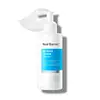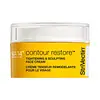What's inside
What's inside
 Key Ingredients
Key Ingredients

 Benefits
Benefits

 Concerns
Concerns

 Ingredients Side-by-side
Ingredients Side-by-side

Water
Skin ConditioningGlycerin
HumectantPropanediol
SolventCaprylic/Capric Triglyceride
MaskingSorbitan Stearate
EmulsifyingPentaerythrityl Stearate/Caprate/Caprylate/Adipate
EmollientGlyceryl Stearate
EmollientMyristoyl/Palmitoyl Oxostearamide/Arachamide Mea
Skin ConditioningButylene Glycol
HumectantDimethicone
EmollientTocopherol
AntioxidantCarbomer
Emulsion StabilisingArginine
MaskingAllantoin
Skin ConditioningCarthamus Tinctorius Seed Oil
MaskingPanthenol
Skin ConditioningSorbitan Laurate
EmulsifyingHelianthus Annuus Seed Oil
EmollientSodium Hyaluronate
HumectantHydroxyethylcellulose
Emulsion StabilisingAcetyl Dipeptide-1 Cetyl Ester
Skin ConditioningPogostemon Cablin Leaf Oil
MaskingSalvia Officinalis Oil
MaskingElettaria Cardamomum Seed Oil
MaskingDihydroxyisopropyl Palmoylpalmamide
HumectantMadecassoside
AntioxidantBis-Capryloyloxypalmitamido Isopropanol
EmollientStearic Acid
CleansingEctoin
Skin ConditioningPhytosterols
Skin ConditioningAnthemis Nobilis Flower Oil
MaskingMentha Arvensis Leaf Oil
MaskingXylitylglucoside
HumectantAnhydroxylitol
HumectantJuniperus Mexicana Oil
MaskingXylitol
HumectantGlucose
HumectantAcetyl Heptapeptide-4
Humectant1,2-Hexanediol
Skin ConditioningCaprylyl Glycol
EmollientWater, Glycerin, Propanediol, Caprylic/Capric Triglyceride, Sorbitan Stearate, Pentaerythrityl Stearate/Caprate/Caprylate/Adipate, Glyceryl Stearate, Myristoyl/Palmitoyl Oxostearamide/Arachamide Mea, Butylene Glycol, Dimethicone, Tocopherol, Carbomer, Arginine, Allantoin, Carthamus Tinctorius Seed Oil, Panthenol, Sorbitan Laurate, Helianthus Annuus Seed Oil, Sodium Hyaluronate, Hydroxyethylcellulose, Acetyl Dipeptide-1 Cetyl Ester, Pogostemon Cablin Leaf Oil, Salvia Officinalis Oil, Elettaria Cardamomum Seed Oil, Dihydroxyisopropyl Palmoylpalmamide, Madecassoside, Bis-Capryloyloxypalmitamido Isopropanol, Stearic Acid, Ectoin, Phytosterols, Anthemis Nobilis Flower Oil, Mentha Arvensis Leaf Oil, Xylitylglucoside, Anhydroxylitol, Juniperus Mexicana Oil, Xylitol, Glucose, Acetyl Heptapeptide-4, 1,2-Hexanediol, Caprylyl Glycol
Water
Skin ConditioningNeopentyl Glycol Diethylhexanoate
EmollientC12-15 Alkyl Benzoate
AntimicrobialGlycol Distearate
EmollientPalmitic Acid
EmollientGlycerin
HumectantStearic Acid
CleansingUndecane
EmollientCetearyl Alcohol
EmollientMyristyl Nicotinate
Skin ConditioningCetyl Alcohol
EmollientAcetyl Dipeptide-1 Cetyl Ester
Skin ConditioningBeta-Glucan
Skin ConditioningThymus Vulgaris Flower/Leaf Extract
MaskingPaeonia Albiflora Root Extract
Skin ConditioningCommiphora Mukul Resin Extract
Skin ConditioningTetrahydrodiferuloylmethane
AntioxidantOrnithine
Skin ConditioningPhospholipids
Skin ConditioningGlycolipids
Skin ConditioningButyrospermum Parkii Butter
Skin ConditioningSodium Hyaluronate
HumectantSucrose Palmitate
EmollientAdenosine
Skin ConditioningHydroxyethylcellulose
Emulsion StabilisingAllantoin
Skin ConditioningPanthenol
Skin ConditioningHelianthus Annuus Seed Oil
EmollientPotassium Cetyl Phosphate
EmulsifyingCaprylic/Capric Triglyceride
MaskingLevulinic Acid
PerfumingGlyceryl Caprylate
EmollientButylene Glycol
HumectantTridecane
PerfumingPropanediol
SolventIsostearyl Isostearate
EmollientAcrylates/C10-30 Alkyl Acrylate Crosspolymer
Emulsion StabilisingGlyceryl Linoleate
EmollientPentylene Glycol
Skin ConditioningPolysorbate 60
EmulsifyingCetyl Stearate
EmollientLecithin
EmollientTocopherol
AntioxidantCaprylhydroxamic Acid
Sorbitan Laurate
EmulsifyingDisodium EDTA
Ethylhexylglycerin
Skin ConditioningCaprylyl Glycol
EmollientParfum
MaskingCitric Acid
BufferingP-Anisic Acid
MaskingBenzyl Alcohol
PerfumingSodium Hydroxide
BufferingPhenoxyethanol
PreservativePotassium Sorbate
PreservativeLimonene
PerfumingCitral
PerfumingWater, Neopentyl Glycol Diethylhexanoate, C12-15 Alkyl Benzoate, Glycol Distearate, Palmitic Acid, Glycerin, Stearic Acid, Undecane, Cetearyl Alcohol, Myristyl Nicotinate, Cetyl Alcohol, Acetyl Dipeptide-1 Cetyl Ester, Beta-Glucan, Thymus Vulgaris Flower/Leaf Extract, Paeonia Albiflora Root Extract, Commiphora Mukul Resin Extract, Tetrahydrodiferuloylmethane, Ornithine, Phospholipids, Glycolipids, Butyrospermum Parkii Butter, Sodium Hyaluronate, Sucrose Palmitate, Adenosine, Hydroxyethylcellulose, Allantoin, Panthenol, Helianthus Annuus Seed Oil, Potassium Cetyl Phosphate, Caprylic/Capric Triglyceride, Levulinic Acid, Glyceryl Caprylate, Butylene Glycol, Tridecane, Propanediol, Isostearyl Isostearate, Acrylates/C10-30 Alkyl Acrylate Crosspolymer, Glyceryl Linoleate, Pentylene Glycol, Polysorbate 60, Cetyl Stearate, Lecithin, Tocopherol, Caprylhydroxamic Acid, Sorbitan Laurate, Disodium EDTA, Ethylhexylglycerin, Caprylyl Glycol, Parfum, Citric Acid, P-Anisic Acid, Benzyl Alcohol, Sodium Hydroxide, Phenoxyethanol, Potassium Sorbate, Limonene, Citral
Ingredients Explained
These ingredients are found in both products.
Ingredients higher up in an ingredient list are typically present in a larger amount.
Acetyl Dipeptide-1 Cetyl Ester is a peptide composed of amino acids arginine and tyrosine.
This peptide is considered a neurotransmitter peptide, meaning it has pain-relieving and relaxing properties. It has the ability to calm skin irritation from external factors such as chemical stinging or heat.
Neurotransmitter peptides are also often called "botox in a bottle". This is because these peptides have the ability to relax the muscles.
Though relaxing the muscles can prevent expression lines (as we have seen in botox), the studies do not show these peptides to be a botox replacement. The effects of this muscle relaxation is also short-term, as opposed to longer-term results from botox.
Learn more about Acetyl Dipeptide-1 Cetyl EsterAllantoin is a soothing ingredient known for its protective and moisturizingg properties. Because of this, it is often added to products with strong active ingredients.
Studies show higher concentrations of this ingredient can promote wound healing.
Though it can be derived from the comfrey plant, allantoin is produced synthetically for cosmetic products to ensure purity.
Learn more about AllantoinButylene Glycol (or BG) is used within cosmetic products for a few different reasons:
Overall, Butylene Glycol is a safe and well-rounded ingredient that works well with other ingredients.
Though this ingredient works well with most skin types, some people with sensitive skin may experience a reaction such as allergic rashes, closed comedones, or itchiness.
Learn more about Butylene GlycolThis ingredient is an emollient, solvent, and texture enhancer. It is considered a skin-softener by helping the skin prevent moisture loss.
It helps thicken a product's formula and makes it easier to spread by dissolving clumping compounds.
Caprylic Triglyceride is made by combining glycerin with coconut oil, forming a clear liquid.
While there is an assumption Caprylic Triglyceride can clog pores due to it being derived from coconut oil, there is no research supporting this.
Learn more about Caprylic/Capric TriglycerideCaprylyl Glycol is a humectant and emollient, meaning it attracts and preserves moisture.
It is a common ingredient in many products, especially those designed to hydrate skin. The primary benefits are retaining moisture, skin softening, and promoting a healthy skin barrier.
Though Caprylyl Glycol is an alcohol derived from fatty acids, it is not the kind that can dry out skin.
This ingredient is also used as a preservative to extend the life of products. It has slight antimicrobial properties.
Learn more about Caprylyl GlycolGlycerin is already naturally found in your skin. It helps moisturize and protect your skin.
A study from 2016 found glycerin to be more effective as a humectant than AHAs and hyaluronic acid.
As a humectant, it helps the skin stay hydrated by pulling moisture to your skin. The low molecular weight of glycerin allows it to pull moisture into the deeper layers of your skin.
Hydrated skin improves your skin barrier; Your skin barrier helps protect against irritants and bacteria.
Glycerin has also been found to have antimicrobial and antiviral properties. Due to these properties, glycerin is often used in wound and burn treatments.
In cosmetics, glycerin is usually derived from plants such as soybean or palm. However, it can also be sourced from animals, such as tallow or animal fat.
This ingredient is organic, colorless, odorless, and non-toxic.
Glycerin is the name for this ingredient in American English. British English uses Glycerol/Glycerine.
Learn more about GlycerinHelianthus Annuus Seed Oil is the oil derived from the seeds of a Sunflower. Sunflower seed oil is non-fragrant. It is an emollient, meaning it helps to soften the skin.
Sunflower seed oil contains many fatty acids. The fatty acids found in sunflower seeds include (from highest amount to least): linoleic acid, myristic acid, palmitic acid, stearic acid, arachidic acid, oleic acid, and linolenic acid.
These fatty acids help the skin create ceramides. Ceramides play a role in repairing the skin barrier.
Helianthus Annuus Seed Oil helps moisturize the skin. This in turn helps the skin look more rejuvenated and smoother.
Sunflowers are rich in vitamin E.
Historians believe Indigenous cultures of North America domesticated sunflowers before corn. Thus they relied on sunflower oil for a variety of uses. One such use is moisturizing skin and hair.
Sunflower seed oil may not be fungal acne safe. We recommend speaking with a professional if you have any concerns.
Learn more about Helianthus Annuus Seed OilHydroxyethylcellulose is used to improve the texture of products. It is created from a chemical reaction involving ethylene oxide and alkali-cellulose. Cellulose is a sugar found in plant cell walls and help give plants structure.
This ingredient helps stabilize products by preventing ingredients from separating. It can also help thicken the texture of a product.
This ingredient can also be found in pill medicines to help our bodies digest other ingredients.
Learn more about HydroxyethylcellulosePanthenol is a common ingredient that helps hydrate and soothe the skin. It is found naturally in our skin and hair.
There are two forms of panthenol: D and L.
D-panthenol is also known as dexpanthenol. Most cosmetics use dexpanthenol or a mixture of D and L-panthenol.
Panthenol is famous due to its ability to go deeper into the skin's layers. Using this ingredient has numerous pros (and no cons):
Like hyaluronic acid, panthenol is a humectant. Humectants are able to bind and hold large amounts of water to keep skin hydrated.
This ingredient works well for wound healing. It works by increasing tissue in the wound and helps close open wounds.
Once oxidized, panthenol converts to pantothenic acid. Panthothenic acid is found in all living cells.
This ingredient is also referred to as pro-vitamin B5.
Learn more about PanthenolPropanediol is an all-star ingredient. It softens, hydrates, and smooths the skin.
It’s often used to:
Propanediol is not likely to cause sensitivity and considered safe to use. It is derived from corn or petroleum with a clear color and no scent.
Learn more about PropanediolSodium Hyaluronate is hyaluronic acid's salt form. It is commonly derived from the sodium salt of hyaluronic acid.
Like hyaluronic acid, it is great at holding water and acts as a humectant. This makes it a great skin hydrating ingredient.
Sodium Hyaluronate is naturally occurring in our bodies and is mostly found in eye fluid and joints.
These are some other common types of Hyaluronic Acid:
Learn more about Sodium HyaluronateSorbitan Laurate is created from lauric acid and derivatives from sorbitol. It is an emulsifier.
Stearic Acid is a fatty acid. It is an emollient, emulsifier, and texture enhancer.
As an emollient, stearic acid helps soften skin. It aids the skin's protective barrier by preventing water loss. It also provides a gentle cleansing effect without stripping away natural oils.
Stearic acid may also be used to enhance the texture of products. It can add volume and stabilize ingredients such as water and oil. This can help water and oil ingredients from separating.
Sources of stearic acid include animal or vegetable fats/oils such as coconut or shea. It can be naturally found in butter, cocoa butter, shea butter, vegetable fats, and animal tallow.
This ingredient may not be Malassezia folliculitis, or fungal-acne safe.
Learn more about Stearic AcidTocopherol (also known as Vitamin E) is a common antioxidant used to help protect the skin from free-radicals and strengthen the skin barrier. It's also fat soluble - this means our skin is great at absorbing it.
Vitamin E also helps keep your natural skin lipids healthy. Your lipid skin barrier naturally consists of lipids, ceramides, and fatty acids. Vitamin E offers extra protection for your skin’s lipid barrier, keeping your skin healthy and nourished.
Another benefit is a bit of UV protection. Vitamin E helps reduce the damage caused by UVB rays. (It should not replace your sunscreen). Combining it with Vitamin C can decrease sunburned cells and hyperpigmentation after UV exposure.
You might have noticed Vitamin E + C often paired together. This is because it is great at stabilizing Vitamin C. Using the two together helps increase the effectiveness of both ingredients.
There are often claims that Vitamin E can reduce/prevent scarring, but these claims haven't been confirmed by scientific research.
Learn more about TocopherolWater. It's the most common cosmetic ingredient of all. You'll usually see it at the top of ingredient lists, meaning that it makes up the largest part of the product.
So why is it so popular? Water most often acts as a solvent - this means that it helps dissolve other ingredients into the formulation.
You'll also recognize water as that liquid we all need to stay alive. If you see this, drink a glass of water. Stay hydrated!
Learn more about Water